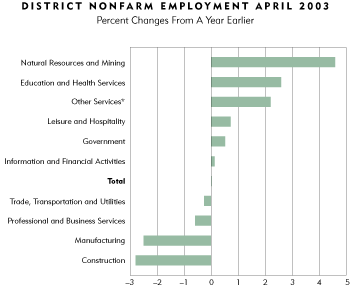Modest growth is projected for the district economy during the second half of 2003 and into 2004, according to the Minneapolis Fed's forecasting models. During the first part of 2003, retail spending grew steadily, while capital spending by businesses was soft. Jobs are expected to grow slowly into 2004, while home building will continue to expand. In agriculture, the first half of 2003 brought significant moisture and decent prices for many major district agricultural products. While the outlook is promising for livestock and crop producers, it is dreary for dairy.
Consumers continue to spend, when will businesses start?
The national economy grew 1.9 percent during the first quarter of 2003, spurred by gains in personal consumption, which grew 2 percent. Consumer spending, which accounts for about two-thirds of total output, has held up during the mild recovery in the national economy since the 2001 recession. Retail spending grew at an inflation-adjusted rate of 1.8 percent in April compared with a year ago. According to reports by district retailers, consumer spending increased at about the same rate as in the nation in April and picked up somewhat in May.
However, it's not the consumer that economists expect will spur an increase in the rate of economic growth, but rather the business owner. Nationally, investments in nonresidential structures, equipment and software decreased in 2001, 2002 and the first quarter of 2003. Combined with stagnant manufacturing activity, these factors contributed to the recession in 2001 and have since kept the cap on growth.
Some positive news was revealed by an informal e-mail survey of business contacts conducted by the Minneapolis Fed in May, in which about twice as many respondents expected to increase capital spending in 2003 from 2002 levels as those who anticipated a decrease. The most-often cited reason for boosting equipment purchases was an expected increase in sales. "Customers appear to be making capital spending decisions on a month-by-month basis depending on sales volume," commented an equipment manufacturer. In addition, several manufacturers reported high capacity utilization at their facilities.
Slow outlook for job growth
While consumer spending is expanding and capital expenditures may begin to turn around, job growth is likely to be slow, according to the Minneapolis Fed's forecasting model (see adjacent page). After district nonfarm employment decreased 0.8 percent in 2001 and held about steady in 2002, employment is expected to increase 1.6 percent in 2003 and 1.3 percent in 2004, which is below the 2.2 percent historical average growth rate for the district.
In April district employment remained level with a year ago. Mining and natural resources grew 4.6 percent in April compared with last year. However, the mining component increased only slightly and remained at historically low levels. Employment in health and education services increased 2.6 percent, and employment in other services, such as repair and laundry services and religious organizations, was up 2.2 percent.
 |
| Source: Bureau of Labor Statistics * Includes repair and maintenance, personal and laundry services, and religious, grantmaking, civic and professional and similar organizations.
Note: The Bureau of Labor Statistics began replacing the old SIC (Standard Industry Classification) system with the new NAICS (North American Industry Classification System) in January 2003. The NAICS provides more broad sectors than the SIC and more detailed categories for the service industries. The new system is common among the United States, Canada and Mexico, allowing for direct comparison of economic data across borders. |
Meanwhile, manufacturing employment decreased 2.5 percent, while construction employment declined 2.7 percent. The transportation employment component of trade, transportation and utilities decreased 0.5 percent, including 1,100 jobs lost in Minnesota due to weakness in air travel.
Home building will grow; large construction is slow
Home building remains strong in part due to low mortgage rates, while nonresidential building is slow. District housing units authorized increased more than 4 percent during the first four months of 2003 compared with last year. District sales of existing homes were up almost 4 percent during the first quarter of 2003 from a year ago. Financial institutions in the district have also reported strong refinancing activity during the first half of 2003.
Meanwhile, high vacancy rates have resulted in soft office building construction. Contracts awarded for public and private buildings were down 11 percent for the first four months of 2003 compared with last year in Minnesota and the Dakotas. A significant amount of office building space remains vacant in the Minneapolis-St. Paul area—16 percent during the first quarter of 2003, up from a low of 5 percent in 1998. The market for retail structures, however, is reported to be relatively healthy districtwide.
Modest price and wage increases expected
Price and wage increases are expected to remain modest for the rest of the year and into 2004. During the first four months of 2003, the Consumer Price Index increased 2.7 percent compared with a year earlier. The Minneapolis Fed's forecasting model predicts that inflation will remain under control, with the CPI increasing 2.8 percent by year end and 2.3 percent in 2004. According to preliminary results of a Minneapolis Fed survey of Minnesota businesses in June, 45 percent of respondents expect wages and salaries at their community's businesses to increase only up to 1 percent during the next six months; another 45 percent expect wages to increase 2 percent to 3 percent.
Some relief from drought brightens agricultural outlook
The first half of 2003 brought significant moisture and decent prices for many major district agricultural products. However, the dairy industry struggled under lower prices and higher costs. The outlook for 2003 and 2004 is encouraging for livestock and crop producers but discouraging for dairy farmers.
Bountiful spring rains mitigated the effects of the dry winter. Respondents to the Minneapolis Fed's first quarter (March) agricultural conditions survey were pessimistic about farm profits and lack of rainfall. However, during April and May buckets of rain fell in most parts of the district and somewhat replenished soil moisture. Montana has generally recovered from the drought, as only 14 percent of the state's topsoil moisture was rated as short or very short compared with nearly 50 percent of the state a year ago. But the drought has not fully disappeared: 31 percent of the state's subsoil moisture was rated as short or very short; however, this was down from 81 percent year ago. The lessening of the drought and solid prices have helped the cattle industry.
The outlook for agricultural income is strong. Cattle prices are expected to remain solid, and some expenses are decreasing as cow/calf operations stop hauling water and hay to animals. In addition, farmers can enjoy the moist soil and sound forecast crop prices. Unfortunately, strong income is not projected for dairy producers, as prices are expected to remain lackluster while input costs increase.
| AVERAGE FARM PRICES | ||||
|---|---|---|---|---|
| 2000/ 2001 |
2001/ 2002 |
Estimated 2002/2003 |
Estimated 2003/2004 |
|
| (Current $ per bushel) | ||||
| Corn | 1.85 |
1.97 |
2.25-2.35 |
1.90-2.30 |
| Soybeans | 4.54 |
4.38 |
5.50 |
4.45-5.45 |
| Wheat | 2.62 |
2.78 |
3.56 |
2.90-3.50 |
| 2001 | 2002 | Estimated 2003 |
Estimated 2004 |
|
|---|---|---|---|---|
| (Current $ per cwt) | ||||
| All Milk | 14.97 |
12.11 |
11.20-11.60 |
11.15-12.15 |
| Choice Steers | 72.71 |
67.04 |
76.00-79.00 |
77.00-84.00 |
| Barrows & Gilts | 45.81 |
34.92 |
38.00-40.00 |
41.00-44.00 |
| Source: U.S. Department of Agriculture, estimates as of June 2003. | ||||






